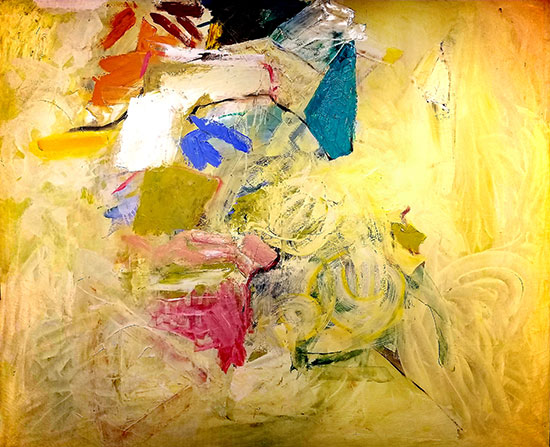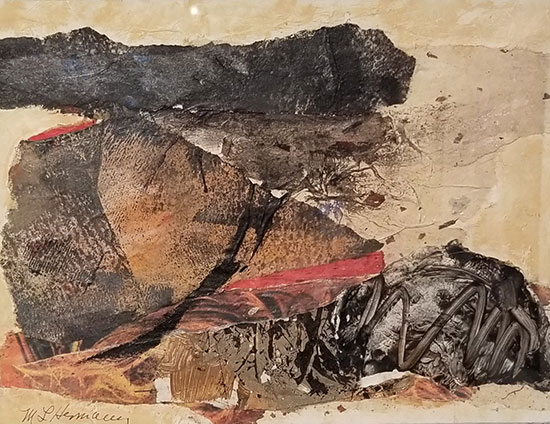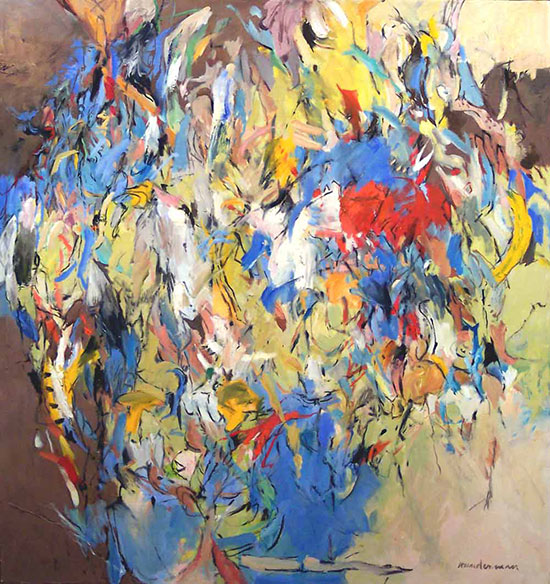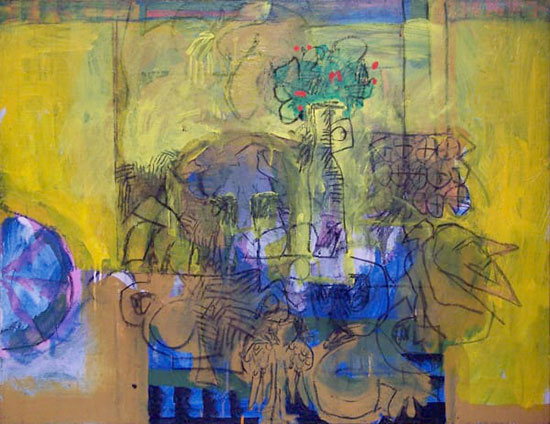Denise Bibro Fine Arts in Chelsea is presenting a sampling of four artists whose careers span decades and whose work is represented in significant private and public collections. And yet, their names may sound as fresh to your ears as those of much younger artists.
Having established their studios in the mid-1950s, Mildred Hermann, Yvonne Thomas, Jan Wunderman and Joseph Stefanelli share not only a generational kinship but also a commitment to the fundamentals of mid-century spontaneity. This commitment apparently proved flexible enough to allow each painter the freedom to evolve continuously, stride through painting’s occasional demise, and confidently negotiate around late modernism’s traffic pileup. By their talent and dogged persistence, their work now brings a long view and a deeper vitality to abstraction’s current considerations. The show is currently on view through March 18, 2018.
To encounter the work of these four artists for the first time today is to see how abstraction’s indomitable individuality structured the historical narrative in circular, not linear, patterns. There is a tendency to overstate traces of influence that declare each painter’s generational moment: de Kooning’s abrupt calligraphy for an older group like this one; Elizabeth Murray’s rounded cutouts for many younger painters. But the unbreakable bond between an artist’s individuality and spontaneous painting as a technique invigorates a sense of shared human experience that challenges fixed notions of progress.
Yvonne Thomas’s The Game, 1960, an approximately six-foot high canvas greeting visitors at the gallery entrance, reads initially as typical of its period, though when considered as thoughtfully as it was painted, one notices a sense of nervous dismissal in passages that first looked like panache. The tracks left by the artist’s brush in large overpainted sections reveal impatience, as if frustration led her to abandon those areas and concentrate on the central third of the picture. And it is this central region that gets resolved, with trapezoidal shards of dense blues and whites that twist and bend as if reconciling their existence to the picture plane. The presence of an open-ended thought process is tangible.
.

"The Game" by Yvonne Thomas, 1960. Oil on canvas, 61.5 x 73.5 inches. Courtesy of Denise Bibro Fine Art.
.
Mildred Hermann’s Untitled No. 12 from the late 1980s is an intimately scaled mixed media collage combining gestural expression with landscape references. It’s 16- by 20-inches dimensions, quite small by mid-century standards, suggests a less public attitude, one that encourages experiment by amplifying the effects of serendipity, and tolerating unorthodox results. Hermann must have seen the landscape elements of a hill and a tree emerging plainly from its torn, folded and smeared surface, yet let it stand, albeit masked by its unobliging title. Allowing a landscape to emerge so literally reflects a contingent outlook.
.

"Untitled, No. 12" by Mildred Hermann, 1989. Mixed Media Collage, 16.25 x 18.75 inches. Courtesy of Denise Bibro Fine Art.
.
Dated 2001, Jan Wunderman’s Crap Shoot, is one of the more recent paintings in the show. Completed in the artist’s 80th year, it’s built upon a gradual opening of space derived from a left-to-right energy flow reminiscent of Jackson Pollock’s seminal canvas Mural, 1943. But Wunderman’s composition breaks from its implied sweep, swells at its center, then halts before it reaches the right edge, fading instead into neutral hues.
.

"Crap Shoot" by Jan Wunderman, 2001. Oil on canvas, 34.25 x 32.5 inches. Courtesy of Denise Bibro Fine Art.
.
As if to balance the final image, she then obliterates the left corners with dark, earthy strokes, fudging the frame’s extremities like a cubist. The similarity is unmistakable, but I don’t feel Wunderman is indulging here in some glib historicism. Her solution accedes to the picture’s innate assertions, an instinctive choice as fundamental to abstraction today as it was 70 years ago.
By 1999, Joseph Stefanelli’s Yellow Concern suggests he, too, had grown beyond his mid-century roots without changing his fundamental process. Dragging charcoal through wet paint, a common pairing of mid-century painting, the artist imposes a traditional still life onto the surface. A wine bottle is below a blossom of either mistletoe or holly and sleigh bells; a winged angel floats somewhere above and within the expressive paint handling. Here the artist seems attentive perhaps to one of de Kooning’s aphoristic gems that may be paraphrased as: first it seems crazy to paint a figure, then it seems crazy not to—originally a gauntlet thrown at the feet of Clement Greenberg and his one-way avant-garde. In Yellow Concern, Stefanelli enthusiastically invites figurative guests to his abstract party.
.

"Yellow Concern" by Joseph Stefanelli, 1999. Acrylic on canvas, 48.5 x 60.25 inches. Courtesy of Denise Bibro Fine Art.
.
The exhibition’s announcements include the name John Hultberg, whose work suffered a logistical mishap and had to be left out. Contrary to corporate notions of professionalism, his absence speaks to something casual and familial. Since the art fair behemoth began devouring the crowds, the press and most of the commerce, relocating them to places requiring airfare and lodgings, the city’s art community continues to lose ground to an absurdly expensive global model. What seems different now about Denise Bibro’s space is how it resembles an old and revered bookstore, where small stacks of reserves and recent deliveries can be gently moved aside by a patron whose presence is assumed and respected as participatory.
In this show, most of the canvases are carefully installed while a few are left casually leaning against a wall, indicating a recent exchange of thoughts, perhaps a sale—surely a conversation of some kind. This gallery, like many others that survive, is more than a showroom and considerably more than a booth at a bazaar. It is designed as a meeting place halfway between one’s home and an artist’s studio, where a weary art fair patron may find a neglected treasure, especially in a show like this.
_________________________
BASIC FACTS: “Titans Within the Rough” is on view February 1 to March 18, 2018 in Gallery I at Denise Bibro Fine Art, 529 West 20th Street, New York, NY 10011. www.denisebibrofineart.com
_________________________
Copyright 2018 Hamptons Art Hub LLC. All rights reserved.
